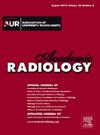The Value of Machine Learning-based Radiomics Model Characterized by PET Imaging with 68Ga-FAPI in Assessing Microvascular Invasion of Hepatocellular Carcinoma
IF 3.8
2区 医学
Q1 RADIOLOGY, NUCLEAR MEDICINE & MEDICAL IMAGING
引用次数: 0
Abstract
Rationale and Objectives
This study aimed to develop a radiomics model characterized by 68Ga-fibroblast activation protein inhibitors (FAPI) positron emission tomography (PET) imaging to predict microvascular invasion (MVI) of hepatocellular carcinoma (HCC). This study also investigated the impact of varying thresholds for maximum standardized uptake value (SUVmax) in semi-automatic delineation methods on the predictions of the model.
Methods
This retrospective study included 84 HCC patients who underwent 68Ga-FAPI PET and their MVI results were confirmed by histopathological examination. Volumes of interest (VOIs) for lesions were semi-automatically delineated with four thresholds of 30%, 40%, 50%, and 60% for SUVmax. Extracted shape features, first-, second- and higher-order features. Eight PET radiomics models for predicting MVI were constructed and tested.
Results
In the testing set, the logistic regression (LR) model achieved the highest AUC values for three groups of 30%, 50%, and 60%, with values of 0.785, 0.896, and 0.859, respectively, while the random forest (RF) model in 40% group obtained the highest AUC value of 0.815. The LR model in 50% group and the extreme gradient boosting (XGBoost) model in 60% group achieved the highest accuracy, each at 87.5%. The highest sensitivity was observed in the support vector machine (SVM) model in 30% group, at 100%.
Conclusion
The 68Ga-FAPI PET radiomics model has high efficacy in predicting MVI in HCC, which is important for the development of HCC treatment plan and post-treatment evaluation. Different thresholds of SUVmax in semi-automatic delineation methods exert a degree of influence on performance of the radiomics model.
基于机器学习的68Ga-FAPI PET放射组学模型在肝癌微血管浸润评估中的价值
基础与目的:本研究旨在建立以68ga -成纤维细胞活化蛋白抑制剂(FAPI)正电子发射断层扫描(PET)成像为特征的放射组学模型,以预测肝细胞癌(HCC)的微血管侵袭(MVI)。本研究还研究了半自动描述方法中最大标准化吸收值(SUVmax)的不同阈值对模型预测的影响。方法:回顾性研究84例肝癌患者行68Ga-FAPI PET检查,经组织病理学检查证实其MVI结果。病变的感兴趣体积(VOIs)被半自动划定为SUVmax的30%、40%、50%和60%四个阈值。提取形状特征,一阶、二阶和高阶特征。构建了预测MVI的8个PET放射组学模型并进行了测试。结果:在测试集中,logistic回归(LR)模型在30%、50%和60%三组的AUC值最高,分别为0.785、0.896和0.859,而随机森林(RF)模型在40%组的AUC值最高,为0.815。50%组LR模型和60%组极端梯度增强(XGBoost)模型的准确率最高,均为87.5%。支持向量机(SVM)模型在30%组灵敏度最高,为100%。结论:68Ga-FAPI PET放射组学模型预测肝癌MVI具有较高的疗效,对肝癌治疗方案的制定及治疗后评价具有重要意义。半自动分割方法中SUVmax阈值的不同对放射组学模型的性能有一定的影响。
本文章由计算机程序翻译,如有差异,请以英文原文为准。
求助全文
约1分钟内获得全文
求助全文
来源期刊

Academic Radiology
医学-核医学
CiteScore
7.60
自引率
10.40%
发文量
432
审稿时长
18 days
期刊介绍:
Academic Radiology publishes original reports of clinical and laboratory investigations in diagnostic imaging, the diagnostic use of radioactive isotopes, computed tomography, positron emission tomography, magnetic resonance imaging, ultrasound, digital subtraction angiography, image-guided interventions and related techniques. It also includes brief technical reports describing original observations, techniques, and instrumental developments; state-of-the-art reports on clinical issues, new technology and other topics of current medical importance; meta-analyses; scientific studies and opinions on radiologic education; and letters to the Editor.
 求助内容:
求助内容: 应助结果提醒方式:
应助结果提醒方式:


